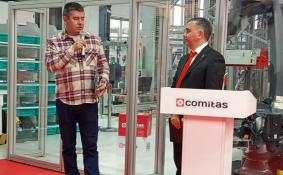Scientific & Practical Journal


Editorial News
Dear readers! We are pleased to present to you the eleventh issue of the journal in 2025. There are a lot of relevant and useful materials in the issue, which, hopefully, will not be ignored.
Dear readers! In September the CeMAT RUSSIA exhibition was held, which showed everyone that innovations and robotics are increasingly penetrating the logistics industry. We can safely say that many technologies are tested here, and only then they go out into the world. However, it is not only CeMAT RUSSIA that demonstrates the prevalence of the digital agenda.
Dear readers! This is the ninth issue of the journal, which turned out to be very rich and diverse. Traditionally, the issue is opened by an analyst. The material by Alina Nasyrova from the Market Guide Agency, dedicated to investments in warehouse complexes in Russia, recalls the importance of developing logistics infrastructure for the integrated development of regions.
PHOTO OF THE WEEK
CITATIONS
Heading:PROBLEMS AND OPINIONS
When it is worth arguing about the logistics theory (in order of discussion)
Dmitry Novikov7 / 2016 | PROBLEMS AND OPINIONS
In order of discussion the article considers the conceptual apparatus of logistics and its source postulate expressions related to incorrectness and inaccuracies. According to the author, it largely prevents from using the real possibilities of logistics and implementing its development under new conditions. And above all, it refers to the objects of logistics management and service.
Key words. The conceptual apparatus of logistics, definition of logistics, flow processes, types of logistics, logistics methodology.
The role of the Customs Service of Russia in the projects for the development of transport and logistics corridors in Eurasia
Klavdy Kornyakov7 / 2016 | PROBLEMS AND OPINIONS
The article discusses the role of Customs Service in the development of transport and logistics corridors, prospects for the development of “Silk Road Economic Belt”, the relationships of the countries concerning the formation and construction of the infrastructure in the economic belt, participation of the Customs Services in the projects of transport corridors.
Key words. Economic belt, information intercommunication, international transport corridor, transit, investment.
Optimization of the transport and logistics structure of a region
Oksana Rozhko, Vadim Khomenko7 / 2016 | PROBLEMS AND OPINIONS
The article proposes method of criteria estimation of the logistics potential of the region, allowing objectively estimating the share of each region in an integrated transport and logistics system and optimizing its operation through the creation of a developed structure of logistics centers.
Key words. Logistic potential, transport systems, cargo turnover, logistics centers.
Creation of tourist clusters in the regions of Russia
Marina Sheresheva6 / 2016 | PROBLEMS AND OPINIONS
The article deals with problems and prospects of the Russian tourism market that is characterized not only by quantitative growth, but also significant changes in strategic approaches. The author analyzes Russian institutional environment specifics and its influence on networking and supply chain management in the tourism cluster.
Key words. Clusters, tourism, networking, supply chain management.
Features of flow processes and their parameters in the tourist logistics
Tatyana Rodkina6 / 2016 | PROBLEMS AND OPINIONS
The article discusses the current state of the Russian Federation, the tourism industry, especially detected flow processes and their basic parameters in the tourism industry, outlined the direction of development of the logistical approach to the solution of major problems.
Key words. Logistics tourism, flow process in industry of tourism, material flow, information flow, tourist information.
Global cities as centers of international tourism
Nikolay Sluka, Martin Pilka6 / 2016 | PROBLEMS AND OPINIONS
Global cities are the key elements of spatial organization of the world's tourism industry. Investigating their experience regarding superiority buildup and overcoming challenges is a great opportunity for Moscow and other Russian cities to solidify their spot in the international tourism market.
Key words. International tourism, global city, success factors, new challenges.
Development of the Transport and Logistics System of Moscow Agglomeration
Suren Vardanyan, Svetlana Domnina5 / 2016 | PROBLEMS AND OPINIONS
In this paper, there are the Moscow Agglomeration in several territorial levels, the features of the logistics development in Moscow and the Moscow region, an integrated approach to logistics in Moscow Agglomeration.
Key words. Moscow agglomeration, the logistics development, integrated approach.
Evaluating the prospects of RFID system implementation within a warehouse complex on the example of LLC Elmat
Nikolay Maltsev5 / 2016 | PROBLEMS AND OPINIONS
The article analyzes the work of a storage complex of industrial enterprise LLC “Elmatˮ and identified the existing problems. The essence of RFID technology, the advantages and disadvantages are described. The work includes experience of companies that have implemented RFID-technology. Authors distinguish the stages of implementation of the pilot project of RFID, name benefits and possible difficulties of implementation this technology in LLC “Elmatˮ.
Key words. Storage system, RFID, barcode, RFID-technology.
The concept and content of non-commercial logistics (Part 1)
Vladimir Stepanov, Andrey Rykalin, Olga Vorobyova5 / 2016 | PROBLEMS AND OPINIONS
In this article it tackles the issues of non-profit-making logistic activities, its concept and content. Also it treats a question about difference between non-profit-making and traditional profit-making logistics. In addition the concept of non-profit-making logistics is confirmed by real examples of providing consumers with products of industrial purpose and consumer goods.
Key words. Non-profit-making logistics, government procurement, state reserve, assistance to refugees, housekeeping.
Modification of M. Porter’s concept on the basis of financial logistics tools
Andrej Butrin5 / 2016 | PROBLEMS AND OPINIONS
In the article the author's method of building an efficient value chain, based on the well-known concept of the value of M. Porter. Its novelty lies in the active involvement of the financial logistics unit.
Key words. Value chain, supply chain, financial flow.












